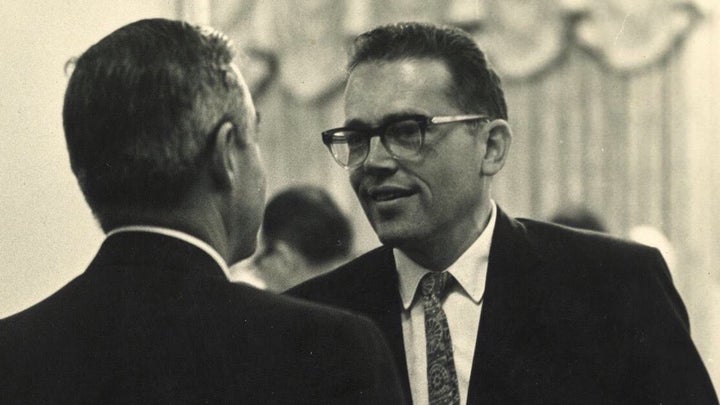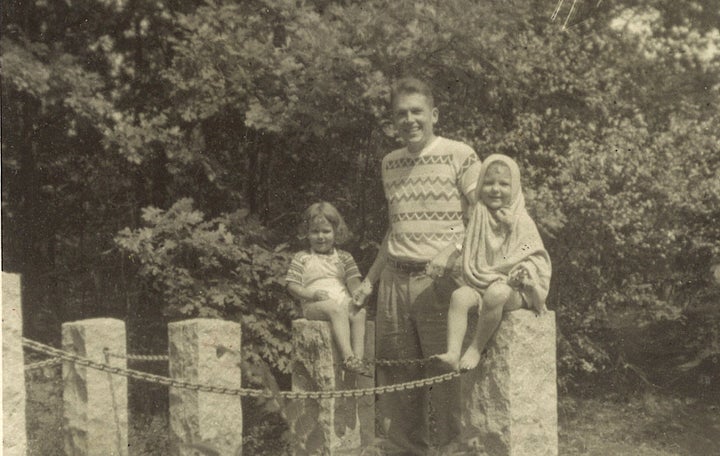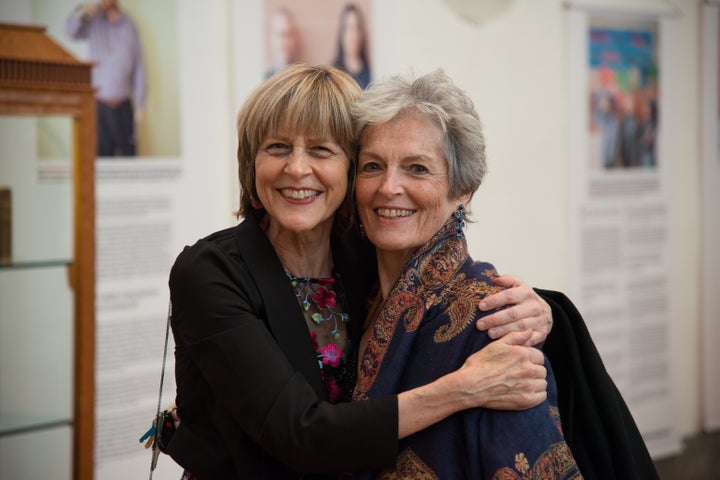
Sig Synnestvedt with Governor William Scranton (PA) circa 1965
Long before Michelle Alexander, Ibram X. Kendi or Black Lives Matter began helping us to get “woke” about the systemic racism that continues to plague our social conscience, Sig Synnestvedt presented a book called, The White Response To Black Emancipation. In it he talked about white America’s lost opportunity, during post-Civil War Reconstruction, to reconcile the moral crimes perpetrated during the previous 250 years against black Americans.
Before continuing, I need to provide the phonetic pronunciation of our subject’s name because you will want to share the story of Mr. Synnestvedt. You can’t just skip this part and vow to Google it because Sig’s biographical information is hard to find: Sin - est - vet. In an effort to give my readers what the Internet can’t, I’ve invited two of his beautiful daughters, Barbara Synnestvedt Karas and Nancy Synnestvedt, to join me to discuss their father’s background, his ideas and how those ideas are more relevant than ever. What better day to celebrate Sig than on the anniversary of his birthday, November 13, 1924?
Robert: Barbara, tell me something about your father's upbringing.
Barbara: Sig grew up in the beautiful town of Bryn Athyn, Pennsylvania in a deeply religious Christian community based on beliefs derived from the writings of Emanuel Swedenborg, which are held by followers to be divinely inspired. At that time, Bryn Athyn was politically conservative and strongly Republican.
Sig’s father was a lawyer in Philadelphia and his mother was a professional nurse until she got married at age 32. Both parents were keenly interested in education and the children—both boys and girls—were expected to go to college. There was a strong emphasis on reading, on music, and on hard work. The family was comfortable financially and had two black maids (as they were then called) who came on certain days to do laundry, cooking, and cleaning. The maids did not live in but were given a room and bathroom in the attic for their use. The two women, who worked for the family during Sig's upbringing, were a mother and daughter. Sig's sister, Helga remembers that she considered these two women to be good friends. However, there is no doubt that Sig's mother, Gertrude, in particular, expected these women to "know their place" as was the custom of the time even in the North. Gertrude grew up in Baltimore, with Southern leanings and she embraced the accepted theory of the racial superiority of white people, which she was not slow to express.
Sig served in the Navy during World War II, and returned to get his BA and MA degrees in American history on the GI Bill from Michigan State University. He was hired by the Academy of the New Church in Bryn Athyn and taught for 18 years at both the high school and college level: American History, Current Events, Public Speaking, and Great Books. He loved poetry and philosophy, and subsequently received his PhD from the University of Pennsylvania with a dissertation on ‘Bread, Beauty and Brotherhood: The Ethical Consciousness of the Poet Edwin Markham.’ His admiration and study of Markham no doubt influenced his deep belief in the brotherhood of mankind.
One of Sig's favorite poems by Markham was ‘Outwitted.’

Robert: Nancy, do you know whether or not Sig demonstrated an inclination for social justice early in his life?
Nancy: It's clear to us that he had a strong sense of social justice, but it's not clear exactly how early in his life this started, or indeed how it started, given the racial prejudice he observed—in his mother at least—and, undoubtedly, in other people in Bryn Athyn.
Our mother, Nadine Synnestvedt, recounted something that Sig had talked about: that when one of the maids would accompany the Synnestvedt children to the movies as a chaperone, the "Negroes" had to sit in the balcony rather than in general seating. Sig was distressed by this practice. He esteemed these women and did not think it was fair that they had to sit apart in the less desirable seats. In those days, strict segregation was the norm in the North as well as the South, but perhaps this was his first public experience of it.
Helga remembers that both of her older brothers were exceptionally kind big brothers, but she didn't remember whether Sig demonstrated an early sense of social justice. His sense of injustice at the segregated seating in the movie theater, however, was something he still talked about as an adult.
During the war, blacks were assigned the menial and unglamorous jobs and he is likely to have noticed this in the Navy. Sig was a huge baseball fan throughout his life and was no doubt aware of the separation of the races into the negro and white leagues. Both the military and the major leagues were desegregated in the years after the War. He was an avid reader of the newspaper and would have been informed about the struggles to integrate different parts of society.
As young men, Sig and his brother, John became strong Democrats—two of only a handful in the Bryn Athyn community. It’s likely that their ‘liberal’ views strengthened during the Civil Rights Era in the 60s. I remember specific arguments that Sig and John had with their mother about the topic of race. They accused her of being a bigot and tried to change her views about black people. Gertrude always claimed that she didn't think they were less worthy; rather, that they were just different. Sig would respond that all the differences she pointed out about blacks were perceived inferiorities not objective differences.
Robert: How do you think your father became a practicing white anti-racist?
Barbara: Nancy and I, along with our other siblings, would all say that the essential characteristic of our father was his sense of truth, fairness, and justice. He was good-natured and even-tempered, but he got angry if anyone was badly treated, and he wasn't afraid to stick up for the underdog.
As an outspoken "middle of the road liberal" (as he described himself) who believed in social equality and a degree of socialism, Sig was subjected to criticism and even ridicule. He was considered “a Commie" by some people in Bryn Athyn and was passed over for promotion although he was academically the most qualified in his department and one of the most popular teachers at the school; his views were seen as too radical. It may be that the discrimination he was subjected to on account of his political views fueled his sense of social justice. Certainly his deep study of American history, in particular the Civil War, would have informed his political views. The television coverage of the Civil Rights activism and school desegregation almost certainly crystalized his belief in the importance of "inalienable human rights" available to all.
In 1968, Sig took up a new position at the State University of New York in Brockport and the following year he was appointed Chairman of the History Department. Here his career as historian, teacher, and advocate for civil rights took off. Believing that white people had to educate their white brothers and sisters on matters of race and equality, he began work on his book, The White Response to Black Emancipation, published in 1972, and thereafter used as a text for the course he taught by the same name.
Sig recruited new members of the History department, with a particular focus on women candidates and black scholars. He was responsible for hiring members of the new African Studies Department (which later became ‘Afro-and African American Studies.’)
Nancy: I don't recall ever being embarrassed by our father's willingness to be different from the community norm, and to be outspoken about it. We were proud to be his children. He was different from other fathers in lots of ways. He made us memorize poetry, speeches, and songs by heart as we walked the mile and a half to school with him. We learned the Gettysburg Address, Paul Revere's Ride, the Concord Hymn, ALL the verses of The Battle Hymn of the Republic and other works by various American poets. He typed up inspirational quotes and put them on the bathroom mirror, which the whole family absorbed. One of his favorites was from Henry David Thoreau: "If you have built castles in the air, your work need not be lost; that is where they should be. Now put the foundations under them."
There were extended-family trips to Gettysburg, high school field trips to Washington DC, and college trips to Concord, Massachusetts, etc. With Dad as our ‘docent’, we enjoyed learning a lot of American history--although we took exception to the time he stood on the tailgate of our car in the parking lot at Gettysburg and belted out Civil War songs! Dad took Barbara and me out with him to knock on doors during the campaign for JFK in 1960, and we remember him talking enthusiastically about social change to anyone who was willing to engage in discussions.
At the devastating news of Kennedy’s assassination, Sig and Nadine immediately got together with John and Marion Synnestvedt, and decided they needed to go to Washington to be part of the ceremonies to honor this man. It was our mother’s idea to take all the children from both families too, so we piled in the cars and drove down to Washington, missing two days of school, which was unheard of for us. It was a powerful experience to be in the somber atmosphere, to witness the funeral parade and to file through the U.S. Capitol Building.

Nancy, Sig and Barbara at the site of Henry David Thoreau’s cabin on Walden Pond
Robert: Nancy, what is the role of white Americans, as expressed in your father's work, who want to change the paradigm of racism?
Nancy: In the Epilogue of "The White Response to Black Emancipation," my father responds to the question posed by many of his students: "What can I do?" He urged white people to seek the power of knowledge and to take action. He wrote that many of his students reported profound changes in their thinking as a result of taking his course. They even included a self-confessed ardent white supremacist who took the course with the idea that he would expose the fraud that Synnestvedt was perpetrating. This student came to accept that America has been racist at its core; he told my father that the book and the course had changed his entire life.
Sig wrote: “…I insist that only through their efforts will America change where it has to change the most – within the white majority. Every segment of white society, every institution, bureau, business, union, association, in a word, every aspect of white society must be studied and where injustice exists, it must be exposed and changed."
He acknowledged that this process would not change the minds of all whites regarding the nature of the white problem in America. "But,” he said, “if justice be placed above self-interest, society can be forced to act properly regardless of continued intolerance in the minds of many. Eventually, with a new generation, intolerance may subside. But the precondition for tolerance is absolute justice." To people who accept these concepts but still have trouble visualizing what they themselves can do, Sig advised: "Working to affect the thinking of racist-minded roommates, friends, and relatives, using the books and articles from the course [White Response to Black Emancipation] often leads to personal experiences which, though causing strained relations at times, cause further ideas for specific action to flow. Opportunities to influence people can be found in the largest city or the most remote, rural village. And whites also must learn to fight, even at times by confrontations, for the absolutely equal application of the national creed."
“Keeping the black man ‘in his place’ is unquestionably the greatest folly America has ever entered upon.”
Robert: Barbara, who are some of the contemporary thinkers that best reflect Sig's ideals?
Barbara: There are many contemporary thinkers, writers, activists, and movements that our father would have supported. He would have been especially in tune with the people who promote education and action; he believed in the power of knowledge, plus rolling up your sleeves and doing what needs to be done. He would have taken part in organizations and movements that educate white people to shun racism in all its subtle and manifest forms. Organizations like Frederick Douglass Family Initiatives, Showing Up For Racial Justice, and Equal Justice Initiative reflect his ideals strongly. Sig would have been fully on board with writers/thinkers like Bryan Stevenson, Michelle Alexander, Carol Anderson, and Ibram X. Kendi, to name just a few. Indeed there are a large number of contemporary writers who are deeply investigating institutionalized white racism and its impact on people of color, both historically and currently.
He would have also embraced the internet and social media, and been excited by the many avenues it has opened up for online self-education. Two excellent examples of this are recent blogs on Huffpost by John Metta: ‘I, Racist’ and by The DiDi Delgado, ‘Florida Cop Encourages Black Residents to Die in Hurricane’ on ‘Medium’ (or indeed, any of the articles by The DiDi Delgado).
A clear theme in Sig’s book is that black people and white people have different roles to play in the struggle for equal freedom and justice for all, and this premise is reflected by many current writers, thinkers, organizations, and social media. BlackLivesMatter, Southern Poverty Law Center, Nice White Ladies, and Safety Pin Box are a few of the many examples but there are a host of others, including organizations that are more specifically aimed, e.g. against violence to black women, against racism on campus, etc . Sig’s particular focus was on the need for white people to bring their influence to bear on other white people and institutions, which is where the racism is. “Thousands of white teachers are needed to study the real story of race relations in American and then present it to students at every level of education.” (From his book.)
He would have agreed with people who oppose white saviorism and white fragility.
He would have agreed with the many writers who point out that white privilege and sense of entitlement are so endemic that most whites don’t even know it exists.
He would have agreed with the idea of paying reparations—aka ‘paying what we owe,’ including paying the people who are educating us for free, online and elsewhere.
He was a huge advocate of education, but he also wouldn't have drawn back from confrontation if the need arose; he urged both blacks and whites to do whatever it took.

Nancy Synnestvedt and Barbara Synnestvedt Karas
Robert: Do you two think now is the right time to be agitating against racism?
Barbara and Nancy: YES!! Tragically, the injustices our father wrote about in 1972 are still there, and new and perhaps deeper levels of discrimination now exist: de facto resegregation of the schools; systemic poverty and unemployment; mass incarceration of black youth and appalling treatment of prisoners, as well as other egregious inequalities of the so-called justice system, among other things.
He said: “... if we are to avoid a racial holocaust in America, immense social change must take place rapidly. Most of this change must come in the minds of white Americans who presently enjoy numerous benefits from the white racist policies of the past which have become socially institutionalized.”
He said: “…keeping the black man 'in his place' is unquestionably the greatest folly America has ever entered upon.”
Robert: I appreciate your willingness to stir things up! Thank you, Barbara and Nancy and happy birthday to Sig Synnestvedt. If you have comments or questions, please click the gray dialog box to the left.
Follow me on Twitter @RobertJBenz
